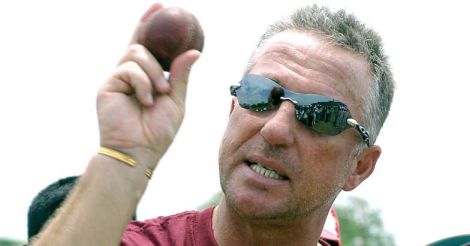The week that went by was an eventful one so far as international cricket was concerned. India staged a comeback after conceding a first innings lead in excess of 100 runs and came close to winning the first Test of the ongoing series against Sri Lanka. The Ashes series for the urn, played between Australia and England, got off at the traditional venue for the first match at Gabba, Brisbane. India’s fightback brought to one’s mind the memory of a sensational Test against Australia at the same venue, when the hosts had shocked the visitors after following on, thanks to a brilliant 281 by V V S Laxman and a superb piece of bowling by Harbhajan Singh. Matches played for the Ashes have produced many thrilling matches, all fought vigorously between the two old opponents, neither of whom are prepared to yield an inch.
To my mind, the most thrilling Ashes Test match has been the one played at Headingley, Leeds, in 1981, which saw England make an amazing comeback after conceding a huge first innings lead and being forced to follow on. To appreciate the nature of the contest and the stakes involved, one needs to dwell a bit into the background of the series and the composition and strengths of the two sides. A brief about the important players involved is also necessary to complete the picture.
Botham's captaincy stint
Ian Botham had taken over as captain of England in 1980, following the retirement of Mike Brearley. Botham had enjoyed a golden run with the bat and ball prior to his ascendancy to captaincy and it was expected that he would install in the English side some of his fighting spirit and flair for the game. However, he was unfortunate that the first two series where he had to lead the side featured Tests against the West Indies, undisputedly the strongest side on the planet. While England lost the first series, which was played at home, by a margin of 0-1, they lost the one played in the West Indies 0-2. While one could understand the reasons for the defeat at the hands of the all conquering West Indians what critics found to be inexplicable was the loss of form of the skipper. Botham appeared to have lost his magic with both and ball, to the extent that he had just a solitary half-century to his credit and the 100s and five-wicket hauls which used to happen at regular frequency suddenly appeared to be ancient memory.
To make matters worse, Botham allowed his failures on the field to affect his persona. An impression gained ground that the skipper was lost in his own world and not bothered about the team and its performances. He became sensitive to criticism and committed the blunder of trying to manhandle a journalist who was critical of his performance. This only resulted in increased criticism about the team and its captain from the hacks who had gone from London to cover the series. The reporters did not give Botham any respite, despite being aware of the many misfortunes that the side faced, including injury to Bob Willis, their bowling spearhead, who was forced to return after suffering an injury in the West Indies.
There was a change at the helm for Australia also as Greg Chappell announced his retirement in 1981, prompting selectors to appoint Kim Hughes as his successor. This had created some amount of heart burn among senior players who had expected Rodney Marsh to get the nod. Though Dennis Lillee and Marsh agreed to play under Hughes, they made no secret of their disappointment in this regard. Australia was in process of building a team after the chaos caused by World Series Cricket and departure from the scene of such distinguished players as Chappell brothers and Doug Walters.
England selectors were perturbed by poor performance of the side and the loss of form of the captain and named Botham as skipper only for the three One-Day Internationals and first two Tests. Australia won the ODI series by a margin of 2-1 as well as the first Test at Trent Bridge, thus pushing England on the blackfoot. Botham knew that his captaincy was on the line when the second Test began, but unfortunately he was dismissed for a duck in both the innings,thus lending an extra sharpness to the knives out for his head. Rather than give the selectors the opportunity for sacking him, Botham decided to quit and announced that he was stepping down from captaincy at the end of the match.
Surprise choice
At this juncture, selectors sprang a surprise. Instead of choosing Bottom’s successor from among the players in the squad or those active in the first class game in the country, they recalled Brearley and requested him to take over as captain. This was an inspired move as Brearley was a person known for his skill in handling people (“bloke with degree on people” as Rodney Hogg once famously said of him). Further, Brearley shared a special relationship with Botham and the latter would not carry any grudges in playing under him.
Hughes won the toss at Hedgingly and after some deep discussion with Marsh and Lillee, decided to bat first. Australia scored 401 in the first innings, helped by a masterly knock of 102 by opener John Dyson and dour half-centuries by Hughes and Graham Yallop. England’s bowling was generally lackluster, except for Botham who started finding his form as the innings progressed. He picked up wickets towards the end of Australian innings to return figures of six for 95.
When England batted, the Australian pace attack comprising Lillee, Terry Alderman and Geoff Lawson made full use of the pitch and the overcast conditions to make life difficult for the batsmen. Wickets fell at regular intervals and except Botham, who made a fighting 50, none of the batsmen could tackle the seam and swing bowling of the Aussie trio, out of whom Lillee scalped four while the other two shared the remaining six.
Forced to follow on after conceding a first innings lead of 227 runs, England top order did not fare much better in the second outing either. They crumbled to 41 for four, after which the innings was steadied by a stand of 64 between Geoff Boycott and Peter Willey. But once the pair was separated, England tumbled to 135 for seven, when Graham Dilley joined Botham at the crease.
Dilley had a bad match with the ball and knew that he was likely to be dropped from the side. He decided to chance his arm and indulge in some lusty hitting. This had a positive influence on Botham who had been rather subdued till then. Both the batsmen decided to take their chances and attacked the bowling. This threw the Aussie bowlers, who had been hitherto having a field day, into a spin and they suddenly they ran out of ideas.
As he started clearing the boundary with the ease of the old, Botham began to smile again, happy at having rediscovered his form with the willow that had deserted him during the days when he was saddled with captaincy. He was batting on 39 when Dilley started hitting out and from there he marched to his century with the help of 14 boundaries and one six. The dismissal of Dilley for a well-struck 56 did not dampen his mood. He continued in the same attacking mode with Chris Old who lent him good support and, together, they took the score to 319. Then in the company of last man Willis, Botham added 37 runs, with the contribution of the former being a mere couple. England innings finally ended with the score at 356 and Botham returned to the pavilion unconquered on 149, scored off 148 balls, with 27 boundaries and one six.
Despite these pyrotechnics with the bat by their former captain, England had little chance of winning the match as Australia were set a target of only 130 runs. Botham opened the bowling with Dilley and sent back Graeme Wood quickly. However, Dyson and Trevor Chappell batted patiently, eschewing all risks and saw through the opening burst by the bowlers. When the score reached 56, it appeared that Australia had the match in their bag. At this stage, when the match looked like slipping out of his hands, Brearley made a move that swung the course of the Test.
Willis was having a poor match going wicketless in the first innings and not being effective in his first spell in the second. Brearley brought Willis from the end opposite to where he had been bowling and told him to go all out at the batsmen at top pace. This yielded results immediately when Trevor Chappell fended off a bouncer to be caught behind the stumps by Bob Taylor. Buoyed by this dismissal, Willis bowled a snorter that squared up new man Hughes forcing him to edge to Botham at third slip. Yallop was greeted by a vicious bouncer which went off his gloves to Mike Gatting at short leg. Thus, in a span of 9 balls in his second spell, Willis had reduced Australia to 58 for four wickets, at which stage lunch was taken.
It was Old who drew first blood after lunch, taking out Alan Border with a beauty that uprooted his leg stump. Willis then removed the first innings centurion and in-form batsman Dyson, who gloved a attempted hook shot to be caught behind. It was not a secret that Marsh was a compulsive hooker and Willis threw the bait with a bouncer which the batsman top edged and the resultant catch was held by Dilley on the long leg fence. And when Lawson failed get his bat out of the way of an outswinger to edge a regulation catch to Taylor behind the stumps, Australia were down to 75 for eight. Willis had at this stage taken six wickets in six overs!
Aussies are renowned for not giving up and fighting till the very end. The ninth-wicket pair of Lillee and Ray Bright decided to bat in the manner of Dilley and Botham. The duo threw their bats at everything and connected a fair bit to push the score along briskly. A couple of difficult catches were dropped in the slip cordon adding to the mounting tension. Finally it took a slower ball from Willis, which Lillee pushed uppishly to mid on where Gatting ran in to take a fine tumbling catch, to break the partnership. Willis followed this with a perfect yorker in the next over to knock back Bright’s middle stump with Australia falling 18 runs short of the target.
Thus the curtains came down on one of the most thrilling Ashes contests. There would be matches where the margins were narrower, but there have not been many Tests where a side that was on the verge of being written off mounted a rearguard fight of such magnitude and snatched victory from the jaws of defeat. Headingley Test might remain recorded in cricket history on account of Botham’s exploits with both bat and ball, deadly spell of bowling by Willis in the last innings and the brilliance of Brearley as captain, but this match would always be remembered by all those who followed it as one that exemplified the meaning of the phrase “glorious uncertainties of the game”.
(The author is a former international umpire and a senior bureaucrat)
Read more from Vantage Point | Ganguly mistakes Bhajji's daughter for son, jokes he's getting old

























 Ian Botham played a big role in England's win over Australia in the Headingley Test. File photo: AFP
Ian Botham played a big role in England's win over Australia in the Headingley Test. File photo: AFP
